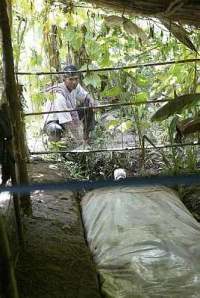
villager with biological gas digester
By KER MUNTHIT
Nget Louns rickety old thatched house is typical of Cambodias impoverished countryside, but it holds a surprise inside: a state of the art, environment-friendly gas stove.
Off the grid as far as most utilities are concerned, her household and 29 others in the village of Tamoung get a steady supply of clean energy from human and animal waste, using a device that not only makes cooking less of a chore, but also keeps their gardens flourishing and helps save the forests.
At the centre of the experiment is a device called a biological gas digester or biodigester which converts a by-product of manure into cooking gas. The technology has taken hold in other countries as a way to generate gas or electricity, and now an independent development group is hoping to spread it to Cambodias poor rural people.
Brendan Boucher, the Australian co-ordinator for the non-profit Cambodian Rural Development Team, which is financed by donations from abroad, introduced the project last year in Tamoung, a village in Takeo province 70km south of the capital Phnom Penh.
Boucher says biogas stoves can help improve food security for villagers and reduce the pressures on Cambodias fast-disappearing forests, which are relied on for firewood.
Som Chhear, 57, says he used to trek 10km from home to find firewood to store for use during the rainy season. When his supply ran low, he had to spend 10,000 riel a month on buying firewood or charcoal from a nearby market.
Now, his biodigester not only provides him with free cooking gas, but also with nutrient-rich effluent organic fertiliser that keeps my vegetable garden green for all seasons. “Sometimes, we even use the power from the generator to operate our karaoke machine and sing for fun,” he says.
 Methane from Community Wastes (Elsevier Applied Biotechnology Series) – BUY IT FROM AMAZON
Methane from Community Wastes (Elsevier Applied Biotechnology Series) – BUY IT FROM AMAZON
Nget Loun, 25, says the biogas stove makes cooking an easier chore. The cooking pots and my hands are no longer dirtied with black smoke from burning wood, she says. And it has absolutely no smell, she adds while opening the gas valve and firing up the stove with a lighter.
Boucher notes an additional benefit: the introduction of toilets, a hygienic convenience absent from most rural Cambodian homes. Human and animal waste is flushed through the toilet into a plastic digester tube 10m long and 1.5m in diameter that sits in a ditch under a thatched roof. At the far end, a knee-deep trench collects liquid residue for use as fertiliser.
A PVC pipe attached to the tubes midsection channels methane gas emitted by the manure mix into a plastic storage bag in the house, from which it is fed into the stove. Each unit cost about 400,000 riel (RM380) to set up.
Boucher says biogas units are part of an integrated development package of water wells, fish ponds, vegetable gardens and training in farming methods, all meant to bolster food security. About half of Cambodias 13 million people live on less than 4,000 riel (RM3.8) a day, so many families are at the mercy of nature for their sustenance. The entire package for Tamoung village cost 540,440,000 riel (RM513,418), which was paid by the Australian government.
Twenty-five biodigesters were installed, serving 30 of the villages 130 families. Ownership of at least three cows was a prerequisite making 100 families eligible and a random drawing selected those who got the systems.
Previous efforts to promote biogas technology in Cambodia more than a decade ago met with limited success. About 500 biogas units were installed but most were abandoned by users within one or two years, says San Thy, a researcher at the Centre for Livestock and Agriculture Development, another non-profit group.
One reason was that peasants failed to keep a suitable number of livestock. Sometimes, needing money, they just sold their entire stock. Without supplies of manure, the digesters simply dont work,San Thy says.
Boucher says that providing villages with integrated systems that include components for sustainable development such as fish ponds and vegetable gardens can generate income to pay for maintenance of the biodigesters.
We dont profess what we do will alleviate poverty throughout Cambodia, but it certainly goes a huge way in improving food security, increasing incomes and the livelihoods of people, he says.
Cambodian villager Nget Loun stands in front of her gas stove in her house in Tamoung village, Takeo province, south of Phnom Penh.
It has been a boon for Chent Dejorith’s family, which raises pigs. He says his brother-in-law figured out how to use the methane gas to power a small generator, which pumps water from their well to sell to other villagers. His family has been using the new technology to generate power for four months.

One Response
https://www.globalgiving.org/projects/biogas-renewable-energy-for-15-rural-cambodian-families